Study on the CBN Wheel Wear Mechanism of Longitudinal-Torsional Ultrasonic-Assisted Grinding Applied to TC4 Titanium Alloy
Abstract
:1. Introduction
2. Establishment of a Wheel Wear Model of TC4 Titanium Alloy in LTUAG
2.1. Analysis of Kinematics Characteristics of TC4 Titanium Alloy in LTUAG
2.2. Establishment of a Grinding Force Model for Titanium Alloy in LTUAG
2.3. Establishment of an Abrasive Particle Surface Temperature Model for TC4 Titanium Alloy in LTUAG
2.4. Establishment of a Grinding Wheel Wear Model in LTUAG for TC4 Titanium Alloy
3. Verification and Analysis of the Grinding Wheel Wear Test of TC4 Titanium Alloy in LTUAG
3.1. Test Conditions and Program
3.2. Test Results and Analysis
3.2.1. Influence of Process Parameters on Grinding Force in LTUAG
3.2.2. Effect of Process Parameters on Grinding Temperature of LTUAG
3.2.3. The Effect of Process Parameters on the Wear Rate of Grinding Wheels in LTUAG
4. Conclusions
- The grinding force model and the grinding abrasive surface temperature model of LTUAG were established based on the single-grain grinding arc length model in LTUAG, and on this basis, the grinding wheel wear model of LTUAG was established by combining the wear model and the bond wear model. The theoretical analysis results showed that the grinding wheel wear rate of LTUAG increased as the grinding depth and workpiece feed rate increased and decreased as the grinding linear speed and ultrasonic amplitude decreased.
- The single-factor test of LTUAG of TC4 titanium alloy showed that the grinding force and grinding temperature increased as the grinding depth and workpiece feed rate increased and decreased as the longitudinal amplitude increased. The grinding force gradually decreased as the grinding wheel speed increased, and the grinding temperature gradually increased as the grinding wheel speed increased. In addition, the variation trend of the experimental results of the grinding force and grinding temperature under different process parameters was consistent with the theoretical prediction results, which verified the accuracy of the established grinding force model and grinding temperature model in LTUAG.
- The single-factor test results of the grinding wheel wear rate of TC4 titanium alloy in LTUAG showed that the use of longitudinal-torsional ultrasonic vibration reduced the wear rate of the grinding wheel by 25.2%, thereby increasing the service life of the grinding wheel and improving the machining efficiency of TC4 titanium alloy. The experimental results of the grinding wheel wear rate were consistent with the theoretical prediction results during LTUAG, which verified the accuracy of the grinding wheel wear model in LTUAG established in this study.
Author Contributions
Funding
Institutional Review Board Statement
Informed Consent Statement
Data Availability Statement
Conflicts of Interest
References
- Baltatu, M.S.; Vizureanu, P.; Sandu, A.V.; Florido-Suarez, N.; Saceleanu, M.V.; Mirza-Rosca, J.C. New Titanium Alloys, Promising Materials for Medical Devices. Materials 2021, 14, 5934. [Google Scholar] [CrossRef] [PubMed]
- Guo, L.; He, W.X.; Zhou, P.; Liu, B. Research Status and Development Prospect of Titanium and Titanium Alloy Products in China. Hot Work. Technol. 2020, 49, 22–28. [Google Scholar]
- Guo, J.; Goh, M.H.; Wang, P.; Huang, R.; Lee, X.; Wang, B.; Nai, S.M.L.; Wei, J. Investigation on surface integrity of electron beam melted Ti-6Al-4 V by precision grinding and electropolishing. CJA 2020, 34, 28–38. [Google Scholar] [CrossRef] [PubMed]
- Wang, K.H.; Wang, L.L.; Zheng, K.L.; He, Z.B.; Politis, D.J.; Liu, G.; Yuan, S.Y. High-efficiency forming processes for complex thin-walled titanium alloys components: State-of-the-art and perspectives. Int. J. Extrem. Manuf. 2020, 2, 20–43. [Google Scholar] [CrossRef]
- Bhaduri, D.; Soo, S.L.; Aspinwall, D.K.; Novovic, D.; Bohr, S.; Harden, P.; Webster, J.A. Ultrasonic Asisted Creep Feed Grinding of Gamma Titanium Aluminide Using Conventional and Superabrasive Wheels. CIRP Ann. Manuf. Techn. 2017, 66, 341–344. [Google Scholar] [CrossRef]
- Yan, Y.Y.; Yan, H.Z.; Liu, J.L.; Niu, Y.; Wang, X.B. The Thermo-mechanical Coupling Model and Experimental Research of Longitudinal and Torsional Ultrasonic Grinding of TC4 Titanium Alloy. CMES 2021, 209, 1–13. [Google Scholar]
- Han, S. Simulation and Experimental Research on Ultrasonic Assisted Grinding of GH4169 Superalloy. Ph.D. Thesis, Dalian University of Technology, Dalian, China, 2021. [Google Scholar]
- Bhushan, B. Mordern Tribology Handbook, 1st ed.; CRC Press: Boca Raton, FL, USA, 2000; pp. 273–312. [Google Scholar]
- Churi, N.J.; Pei, Z.J. Wheel Wear Mechanisms in Rotary Ultrasonic Machining of Titanium. IMECE 2007, 3, 399–407. [Google Scholar]
- Liu, F.; Qin, N.; Niu, J.D.; Zheng, L. Tool Wear Model of Rotary Ultrasonic Grinding for Titanium Alloy Based on Dimensional Analysis Method. Mach. Build. Autom. 2018, 47, 93–95+113. [Google Scholar]
- Liu, F.; Qin, N.; Niu, J.D.; Zheng, L. Finite Element Simulation and Experimental Research on Rotary Ultrasonic Grinding of Titanium Alloy. Chin. J. Eng. Des. 2017, 24, 162–167. [Google Scholar]
- Li, Y.Q.; Xiao, G.; Li, T. Effect of Ultrasonic Assisted Grinding Force for TC4 Titanium Alloy. Master Mech. Eng. 2019, 43, 10–13+63. [Google Scholar]
- Yan, Y.Y.; Wang, X.X.; Zhao, B.; Liu, J.L. Study on the Surface Residual Stress and Experimental of TC4 Titanium Alloy by Longitudinal Torsional Ultrasonic Grinding of TC4 Titanium Alloy. Surf. Technol. 2021, 50, 119–129. [Google Scholar]
- Komanduri, R.; Hou, Z.B. Thermal Modeling of the Metal Cutting Process—Part II: Temperature Rise Distribution due to Frictional Heat Source at the Tool-chip Interface. Int. J. Mech. Sci. 2001, 43, 57–88. [Google Scholar] [CrossRef]
- Komanduri, R.; Hou, Z.B. Thermal Modeling of the Metal Cutting Process—Part III: Temperature Rise Distribution due to the Combined Effects of Shear Plane Heat Source and the Tool-chip Interface Frictional Heat Source. Int. J. Mech. Sci. 2001, 43, 89–107. [Google Scholar] [CrossRef]
- Mao, C. The Research on the Temperature Field and Thermal Damage in the Surface Grinding. Ph.D. Thesis, Hunan University, Hunan, China, 2008. [Google Scholar]
- Liu, F. Research on Grinding Force and Tool Wear in Rotary Ultrasonic Grinding of Titanium Alloy. Ph.D. Thesis, Xi’an Jiaotong University, Xi’an, China, 2017. [Google Scholar]
- Rabinowitwicz, E.; Dunn, L.A.; Russell, P.G. A Study of Abrasive Wear under Three-body Conditions. Wear 1961, 4, 345–355. [Google Scholar] [CrossRef]
- Liu, X.S. Research on the Mechanism and Key Technology of Double Wheel Follow-Up Grinding of High-speed Railway. Ph.D. Thesis, Zhejiang University of Technology, Hangzhou, China, 2012. [Google Scholar]
- Usui, E.; Shirakashi, T.; Kitagawa, T. Analytical Prediction of Cutting Tool Wear. Wear 1984, 100, 129–151. [Google Scholar] [CrossRef]
- Su, C. Research on Key Theory and Technology of Virtual Grinding. Ph.D. Thesis, Northeastern University, Boston, MA, USA, 2009. [Google Scholar]
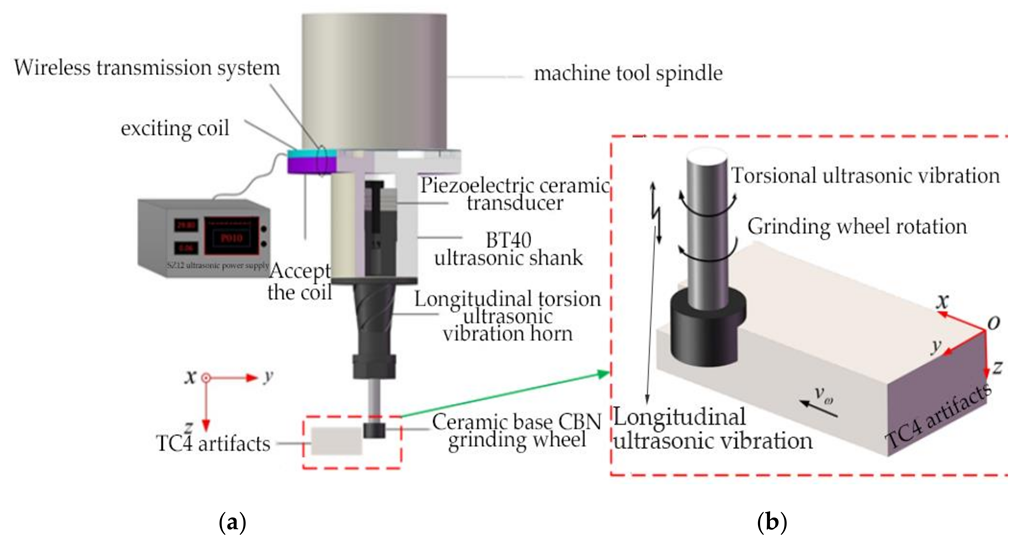

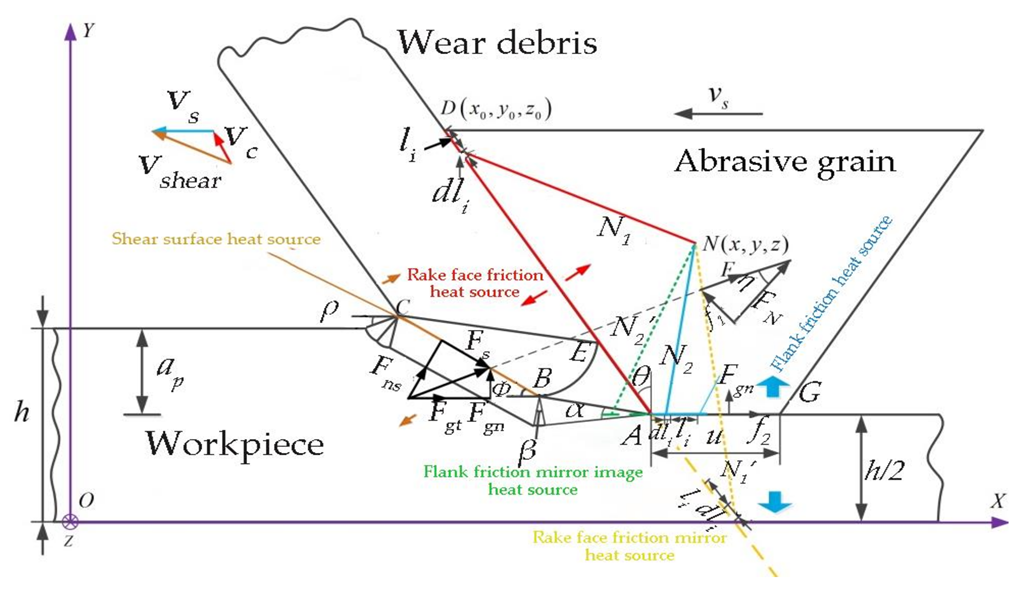

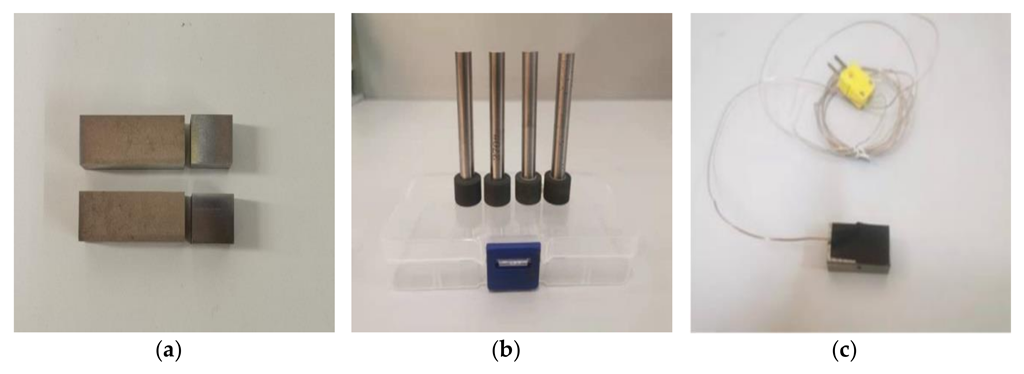
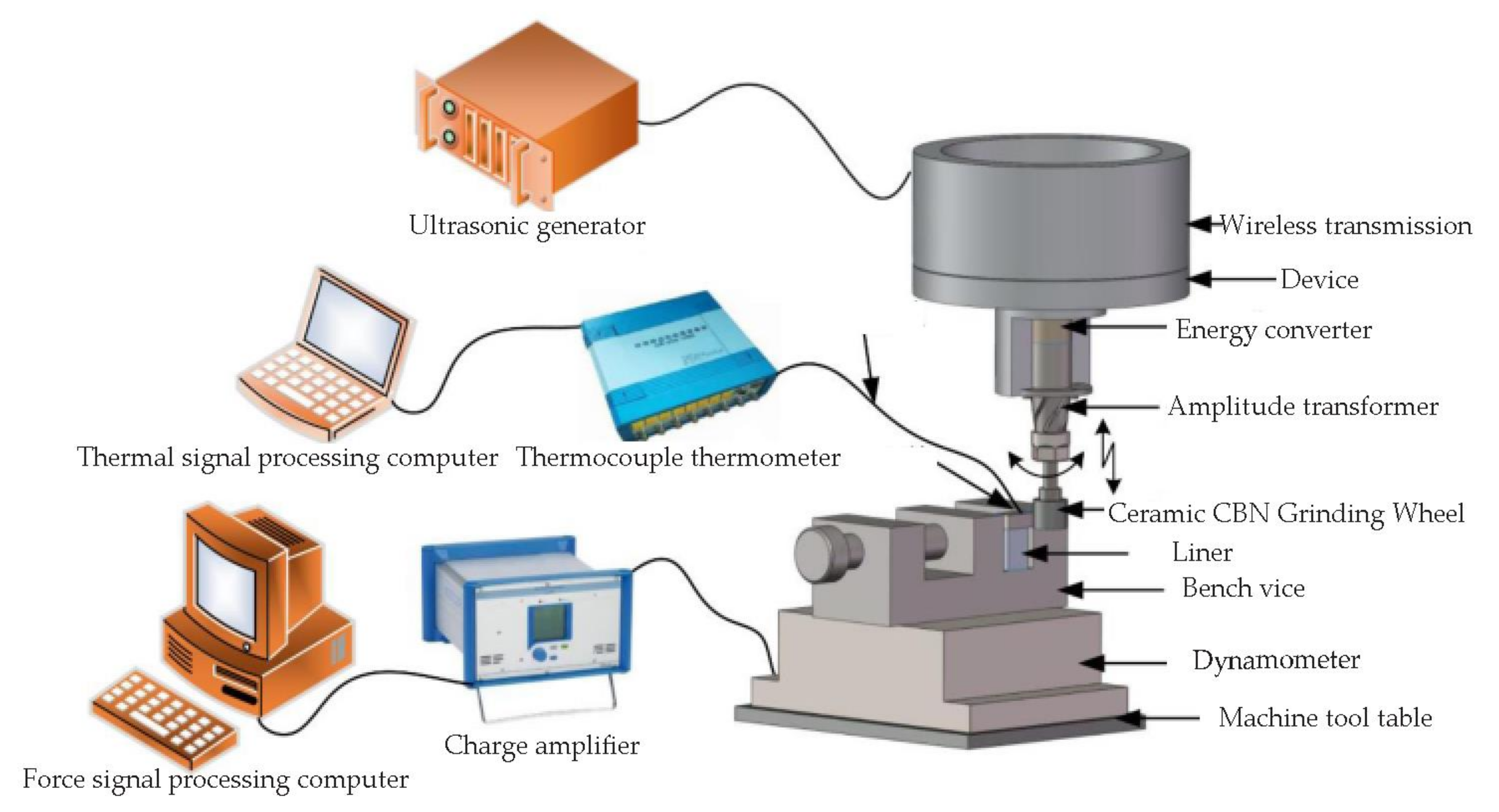


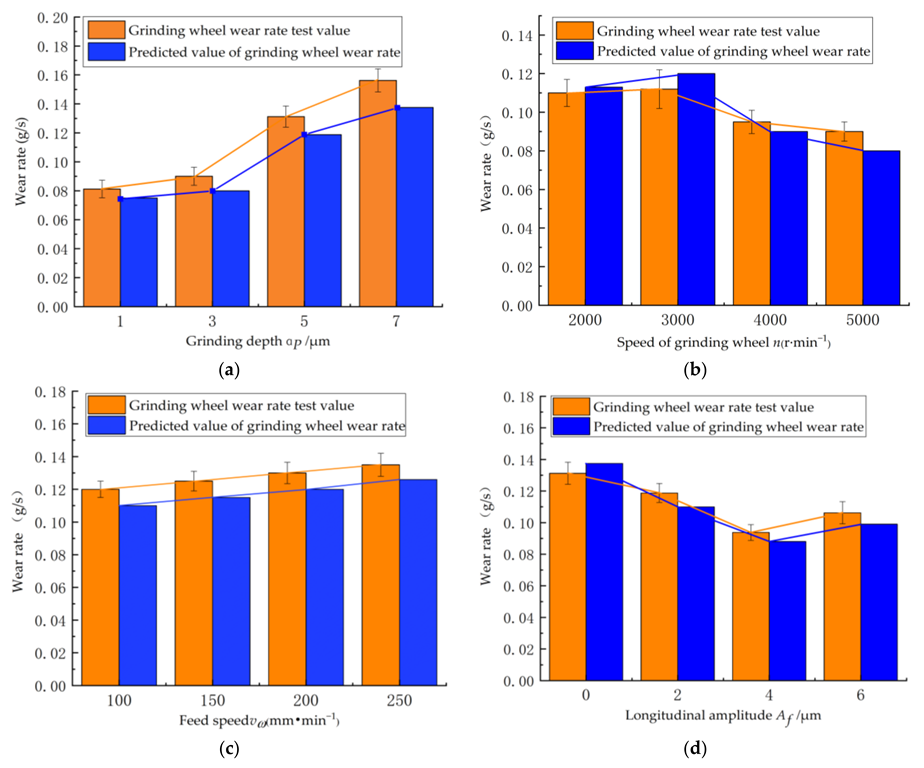
| Project | Parameter |
|---|---|
| The maximum travel of the table (x-axis) | 850 mm |
| The maximum travel of the table (y-axis) | 500 mm |
| Maximum stroke of spindle (z-axis) | 540 mm |
| Range of rotation | 50~8000 r/min |
| Maximum spindle power | 11 kW |
| Maximum output torque | 35.8 N∙m |
| Positioning accuracy | 0.005 mm |
| Project | Parameter |
|---|---|
| Input voltage | AC voltage 220 V |
| Frequency | 50 Hz |
| Output power | Greater than 250 W |
| Frequency adjustable range | 18–23 KHz |
| Project | Parameter |
|---|---|
| Grinding wheel model | 1A1W-type ceramic base CBN flat grinding wheel |
| Manufacturer | Zhengzhou Abrasives Grinding Research Institute Co., Ltd. |
| Grinding wheel length/mm | 10 |
| Wheel diameter/mm | 15 |
| Grinding wheel particle size | 100#, 200#, 300# |
| Grinding wheel concentration | 100% |
| Elongation δ5 (%) | Coefficient of Thermal Conductivity | Density | Tensile Strength | Hardness |
|---|---|---|---|---|
| ≥10 | 7.955 W/m·K | 4.5 g/cm3 | ≥850 MPa | HRC30 |
| Exp. Number | Grinding Depth (μm) | Speed of Grinding (Wheel r/min) | Feed Speed (mm/min) | Ultrasonic Amplitude (µm) |
|---|---|---|---|---|
| 1 | 1/3/5/7 | 4000 | 150 | 4 |
| 2 | 3 | 2000/3000/4000/5000 | 150 | 4 |
| 3 | 3 | 4000 | 100/150/200/250 | 4 |
| 4 | 3 | 4000 | 150 | 0/2/4/6 |
| Grinding Depth (µm) | Wheel Speed (r·min−1) | Feed Speed (mm·min−1) | Longitudinal Amplitude (µm) | Grinding Length (mm) | Wear Rate (g/s) |
|---|---|---|---|---|---|
| 1 | 4000 | 150 | 4 | 150 | 0.0813 |
| 3 | 4000 | 150 | 4 | 150 | 0.0951 |
| 5 | 4000 | 150 | 4 | 150 | 0.1313 |
| 7 | 4000 | 150 | 4 | 150 | 0.1525 |
| 3 | 2000 | 150 | 4 | 150 | 0.1090 |
| 3 | 3000 | 150 | 4 | 150 | 0.1130 |
| 3 | 4000 | 150 | 44 | 150 | 0.0950 |
| 3 | 5000 | 150 | 4 | 150 | 0.0910 |
| 3 | 4000 | 100 | 4 | 150 | 0.1183 |
| 3 | 4000 | 150 | 4 | 150 | 0.1255 |
| 3 | 4000 | 200 | 4 | 150 | 0.1294 |
| 3 | 4000 | 250 | 4 | 150 | 0.1378 |
| 3 | 4000 | 150 | 0 | 150 | 0.1317 |
| 3 | 4000 | 150 | 2 | 150 | 0.1196 |
| 3 | 4000 | 150 | 4 | 150 | 0.0953 |
| 3 | 4000 | 150 | 6 | 150 | 0.1079 |
Publisher’s Note: MDPI stays neutral with regard to jurisdictional claims in published maps and institutional affiliations. |
© 2022 by the authors. Licensee MDPI, Basel, Switzerland. This article is an open access article distributed under the terms and conditions of the Creative Commons Attribution (CC BY) license (https://creativecommons.org/licenses/by/4.0/).
Share and Cite
Liu, J.; Liu, Z.; Yan, Y.; Wang, X. Study on the CBN Wheel Wear Mechanism of Longitudinal-Torsional Ultrasonic-Assisted Grinding Applied to TC4 Titanium Alloy. Micromachines 2022, 13, 1480. https://doi.org/10.3390/mi13091480
Liu J, Liu Z, Yan Y, Wang X. Study on the CBN Wheel Wear Mechanism of Longitudinal-Torsional Ultrasonic-Assisted Grinding Applied to TC4 Titanium Alloy. Micromachines. 2022; 13(9):1480. https://doi.org/10.3390/mi13091480
Chicago/Turabian StyleLiu, Junli, Zhongpeng Liu, Yanyan Yan, and Xiaoxu Wang. 2022. "Study on the CBN Wheel Wear Mechanism of Longitudinal-Torsional Ultrasonic-Assisted Grinding Applied to TC4 Titanium Alloy" Micromachines 13, no. 9: 1480. https://doi.org/10.3390/mi13091480
APA StyleLiu, J., Liu, Z., Yan, Y., & Wang, X. (2022). Study on the CBN Wheel Wear Mechanism of Longitudinal-Torsional Ultrasonic-Assisted Grinding Applied to TC4 Titanium Alloy. Micromachines, 13(9), 1480. https://doi.org/10.3390/mi13091480








